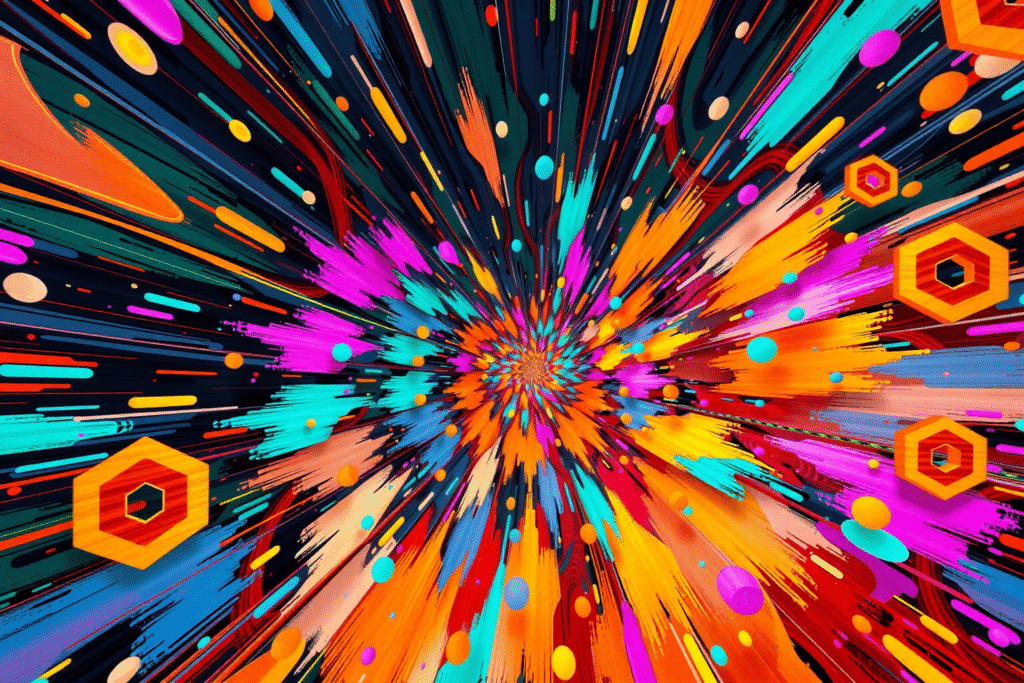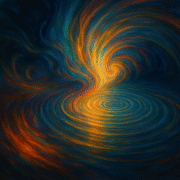
Synesthetic Brushstrokes: Merging Sound and Sight on Canvas” is a captivating exploration of synesthesia art, a genre that fuses music and visual expression to awaken the senses. Through the phenomenon of synesthesia, artists are able to translate auditory experiences into mesmerizing visual compositions, offering viewers a new and immersive way to experience music. This article delves into the history and contemporary uses of synesthesia in art, showcasing how it enhances the sensory and emotional aspects of creative expression. From Wassily Kandinsky to modern day artist Melissa McCracken, we will discover the enchanting power of synesthesia in creating art for the senses.
The Captivating Phenomenon of Synesthesia
Visual Echoes of Sound #1
This brief visual captures the fluid intersection of sound and color—a synesthetic journey where liquid textures and sonic bursts move as one. Let yourself drift into this visual metaphor for what it might feel like to see music.
When we delve into the world of synesthetic art, we find ourselves exploring a fascinating realm that goes beyond the conventional boundaries of perception. Synesthesia is a rare neurological condition that leads to a blending of the senses, where the stimulation of one sense, such as hearing, involuntarily triggers a perception in another, such as seeing. For individuals with synesthesia, the experience of music is not limited to sound alone; it is a vivid tapestry of colors, shapes, and patterns that come to life in their minds eye. This extraordinary perceptual phenomenon has fascinated and inspired a diverse array of artists throughout history, leading to the creation of a unique and captivating art form that continues to intrigue and captivate audiences worldwide.
At its core, synesthesia offers us a window into the exceptional and deeply personal sensory experiences of those who have the condition. It expands our understanding of the human capacity for perception and creativity, encouraging us to reimagine the limitations of our own sensory experiences. Through the lens of art and creativity, synesthesia has opened up new avenues for self-expression and the exploration of the interconnectedness of our senses, inviting both artists and audiences to engage with a world of perception that is as extraordinary as it is awe-inspiring. It is within this context that we can truly appreciate the profound and captivating influence of synesthesia on the art world and the creative landscape at large.
Translating Music into Visual Art
The process of translating music into visual art through synesthesia represents a remarkable and deeply personal journey for synesthetic artists. For these individuals, the act of creating art is not a simple reproduction of sound into visual form; it is an immersive and intuitive process that involves the merging of their sensory experiences. Synesthetic artists are able to take the colors, shapes, and emotions that they perceive in response to music and translate them onto canvas, creating a visual representation of the emotions and moods that the music evokes within them. This ability to see music in a vibrant, tangible way sets synesthetic artists apart, offering them a unique and intimate perspective that enriches their artistic expression in a profound and dynamic manner.
This form of synesthesia art bridges the auditory and visual realms in a uniquely personal way.
Visual Echoes of Sound #2
Just as Melissa McCracken translates melodies into pigment, this sequence explores how rhythmic motion and color can blend into abstract emotional maps. Watch as harmony and hue dance across the screen.
Through the fusion of music and visual art, synesthetic artists like Melissa McCracken and others have continued to captivate audiences with their remarkable ability to convey the essence of a musical piece through their artwork. By harnessing their exceptional sensory perceptions, these artists provide a glimpse into their deeply personal and emotive experiences, inviting viewers to not only admire the beauty of their creations but also to immerse themselves in a world where sound and sight intertwine in extraordinary ways. The ability to experience music in a multi-dimensional, synesthetic manner offers these artists a profoundly unique and intimate lens through which they can explore and express the emotional and sensory dimensions of their creative vision, leaving a lasting impression on the art world and beyond.
Wassily Kandinsky: Pioneer of Abstract Synesthetic Art
One of the most iconic figures in the history of synesthetic art is Wassily Kandinsky, a pioneering artist and visionary whose groundbreaking work and theoretical writings have left an indelible mark on the world of art. Kandinsky, often regarded as the father of abstract art, is celebrated for his ability to “hear” colors and “see” music, a gift that profoundly shaped his artistic output. His visionary approach to creating art that transcended traditional boundaries and genres was underpinned by his deeply personal and synesthetic perception of the world, where he sought to capture the spiritual and emotional dimensions of his experiences through the use of form, color, and composition.
Kandinsky’s iconic compositions, such as “Composition X” and “Yellow, Red, Blue,” are powerful testaments to his ability to harmonize perceptual experiences with artistic expression, showcasing a dynamic interplay of color and form that resonates with a sense of musical and spiritual harmony. His pioneering spirit and innovative approach to abstract art have not only inspired generations of artists but have also paved the way for a deeper exploration of the connections between art, music, and the human experience, reaffirming the timeless and transformative power of synesthetic art in the cultural fabric of our world.
Synchromism: Painting in Color Scales
Visual Echoes of Sound #3
Inspired by Synchromism’s ideals, this clip echoes the logic of music with colors in motion. Think of it as a symphony of light, vibrating in time with invisible chords.
Another significant movement that exemplifies the intersection of color and music in art is the Synchromism movement, which emerged in the early 20th century through the efforts of Stanton Macdonald-Wright and Morgan Russell. Synchromism, derived from the Greek term for “color harmony,” was centered on the creation of visual compositions that paralleled the structures and emotional impact of music. The artists associated with this movement sought to develop a visual language that mirrored the tonal relationships in music, using color scales and compositions to evoke the same emotional responses in viewers as musical harmonies and melodies.
Through their innovative approach, Macdonald-Wright, Russell, and other proponents of Synchromism sought to elevate the medium of painting to a form of visual symphony, where each artwork became a meticulously crafted composition of colors and forms that resonated with the viewer on an emotional and sensory level. The Synchromist movement stands as a remarkable testament to the enduring allure of synesthesia in the realm of art, showcasing the enduring and transformative power of blending the sensory dimensions of sound and sight into a cohesive and harmonious visual experience.
Contemporary Artists Embracing Synesthesia
Continuing the legacy of synesthetic exploration in art, contemporary artists have embraced and expanded upon the concept of blending sound and sight to capture the essence of their sensory experiences. Melissa McCracken, a prominent figure in the realm of synesthetic art, has garnered widespread acclaim for her ability to translate specific songs into mesmerizing abstract paintings, each infused with the unique colors, textures, and emotions she perceives when listening to music. Her artwork serves as a vivid and captivating manifestation of her synesthetic experiences, offering viewers a compelling glimpse into the profound and personal connections she forges between music and visual art.
Through her innovative approach and deeply personal artistic journey, McCracken has exemplified the extraordinary potential of synesthetic art to provide a powerful and immersive platform for self-expression and the translation of sensory experiences into visually evocative forms. Her work stands as a testament to the enduring allure of synesthesia in the contemporary art world, inviting audiences to not only witness the remarkable fusion of sound and sight but also to engage with a deeply emotive and immersive artistic experience that transcends the conventional boundaries of perception and expression.
Melissa McCracken: Seeing Colors in Music
As a synesthetic artist, Melissa McCracken’s unique ability to “see” colors in response to music has been the driving force behind her remarkable artistic journey. McCracken’s captivating and ethereal paintings, often inspired by specific songs or musical compositions, offer viewers a mesmerizing and profoundly intimate reflection of her synesthetic experiences. Each artwork serves as a captivating visual translation of the emotions, colors, and textures that McCracken perceives when immersing herself in the world of music, inviting audiences to partake in her deeply personal and emotive encounters with sound and sight.
McCracken’s artistic prowess and innovative approach to translating her synesthetic experiences into visual art have not only garnered widespread acclaim but have also affirmed her as a leading figure in the realm of synesthetic art, where the convergence of music and visual expression creates a deeply immersive and evocative platform for artistic communication and self-discovery. Her ability to harness the vibrant and dynamic interplay of sound and sight has not only expanded the boundaries of artistic expression but has also offered audiences a profound and captivating lens through which to experience the seamless and transformative union of music and visual art in her exceptional body of work.
Bridging the Gap Between Senses
The intersection of sound and sight in the realm of synesthetic art represents a powerful and transformative medium through which artists can bridge the gap between the senses, inviting audiences to engage with a multi-dimensional and immersive sensory experience. By translating the emotional and sensory dimensions of music into visual forms, synesthetic artists offer a profound and evocative platform for the exploration and appreciation of the interconnectedness of the senses, inviting viewers to partake in a rich and vibrant tapestry of sensory experiences that transcends the limitations of traditional artistic expression. The integration of sound and sight in art not only enriches the sensory experience but also deepens the emotional resonance of the artwork, fostering a profound and transformative connection between the senses and the profound and dynamic expressions of creativity and self-discovery.
Through a seamless and harmonious interplay of color, form, and emotion, synesthetic artists invite audiences to embark on a captivating journey that transcends the conventional boundaries of perception, offering them a unique and immersive lens through which to experience the transformative and transcendent union of sound and sight on canvas. This remarkable fusion of the senses serves as a powerful testament to the enduring and transformative potential of art to not only evoke emotions and perceptions but also to illuminate the profound and intricate connections that shape our understanding of the world and our place within it. As such, the captivating phenomenon of synesthesia stands as a testament to the enduring and transformative power of art to bridge the gap between the senses, inviting us all to partake in a rich and dynamic tapestry of sensory experiences that enliven and enrich our perception of the world around us.
Immersive Experiences Through Color and Sound
The art of synesthesia represents more than just a translation of music into visual art; it is an immersive and deeply personal journey that allows both artists and audiences to engage with a world where sound and sight converge in exquisite and harmonious union. Through the evocative and dynamic interplay of color, form, and emotion, synesthetic artwork offers viewers a vivid and captivating portal into the mind of the artist, where the profound and intimate connections between music and visual expression come to life in all their vibrant and transcendent glory. In this way, synesthetic art stands as a testament to the enduring and transformative power of creativity to not only evoke emotions and perceptions but also to inspire and uplift the human spirit through the seamless and harmonious fusion of sound and sight on canvas.
When engaging with the captivating works of synesthetic artists, audiences are invited to partake in a rich and immersive sensory experience, where the evocative language of color and form converges with the emotional resonance of music to create a deeply emotive and engaging platform for self-expression and artistic communication. The ability of synesthetic art to transcend the boundaries of traditional perception and offer a profound and multi-dimensional lens through which to experience the world affirms its enduring and transformative potential as a powerful medium for exploring, celebrating, and immersing oneself in the harmonious union of sound and sight.
Visionary Harmony: Ace’s Sound in Motion
Concluding this journey, this final piece was inspired by an AI-generated painting rooted in aural emotion. Created from a still image, the motion that unfolds here mirrors the silent pulse of music as seen through the eye of intuition and code.
Enhancing Emotional Connections in Art
Synesthesia art continues to inspire artists and viewers alike through its emotionally immersive qualities.One of the most compelling and enduring aspects of synesthetic art is its ability to enhance and deepen the emotional connections that art fosters between the creator, the observer, and the sensory dimensions of the human experience. By weaving together the evocative threads of sound, sight, and emotion, synesthetic artists offer audiences a profound and intimate platform for exploring the emotional and spiritual dimensions of their creative expression, inviting them to partake in a rich and dynamic tapestry of sensory experiences that transcends the limitations of traditional artistic communication. This remarkable capacity to evoke and amplify the emotional resonance of the artwork speaks to the profound and enduring impact of synesthetic art on the cultural fabric of our world, where the fusion of sound and sight continues to captivate and inspire audiences in ways that are as timeless as they are transcendent.
As viewers engage with the captivating and deeply personal works of synesthetic artists, they are invited to embark on a transformative journey that transcends the boundaries of traditional perception, offering them a unique and intimate lens through which to experience the extraordinary and multi-dimensional interplay of sound and sight on canvas. The seamless and harmonious union of music and visual expression in synesthetic art not only evokes emotions and perceptions but also fosters a profound and enduring connection between the senses and the dynamic and transformative expressions of creativity and self-discovery, reaffirming the enduring and captivating allure of synesthesia as a powerful and evocative medium for enhancing emotional connections and celebrating the extraordinary dimensions of the human experience.
Conclusion
In conclusion, the fusion of sound and sight in the form of synesthetic brushstrokes has resulted in captivating artwork that bridges the gap between auditory and visual experiences. From the pioneering work of artists like Wassily Kandinsky to contemporary artists like Melissa McCracken, synesthesia has elevated the emotional resonance of art and provided a unique way to perceive and appreciate music. This merging of senses not only enhances the overall sensory experience but also invites a deeper connection and emotional response to art.


